19 July 2021
De Rerum Natura and Five Pali Songs: engaging with ancient texts
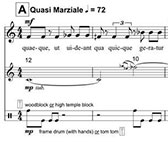
In this article composers and collaborators Peter McNamara and Brad Gill talk about engaging with ancient texts in two works, McNamara's De Rerum Natura and Gill's Five Pali Songs.
In contrast to many, we've managed to find a well of inspiration in texts from another time from two very different ancient societies. In particular, we've both had a deep and extended engagement with texts stemming from these ancient societies, and the works we discuss emerged for each of us over the course of a number of years. We have decided to co-author this article, in part since we co-direct SIDEBAND together and have collaborated on many projects including those discussed here, in that capacity. Perhaps of more interest, however, is presenting our common impulse to engage with the ancient side by side to also highlight our very different approaches: Peter's focus on referencing relevant historical music theory and sonic musical elements, Brad's on the human element of ostensibly religious texts and approaches to improvisation and composition reflective of the spontaneous and meditative qualities of the texts.
Many of today's societal issues and deep human truths also existed in the ancient world, such as philosophical and scientific approaches to inquiry and of course the psychological makeup of what makes us human hasn't changed a great deal. Even pandemic, with the final song of Peter's De Rerum Natura describing conditions during the 430-27 BCE Athens plague. Our article discusses the motivations, struggles and methods applied to ancient Latin and Pali texts in our works. We also hope you find the brief musical insights explored in these song cycles interesting.
Peter McNamara: De Rerum Natura
De Rerum Natura is a song cycle in six parts, that sets portions of the same-titled Latin text completed during the period of the late Roman Republic between c. 55-50 BCE by Titus Lucretius Carus. A mysterious figure, Lucretius was an Epicurean and poet from the same period as Catullus, was most likely born between the years of 99-94 BCE and probably died during the year his only surviving work was completed1.
I was attracted to this thought-provoking text due to its advanced theories of subatomic physics and the formation of the universe. I decided to have Lucretius's words pronounced as closely as possible to how they were when originally written, applying as a result the practice of Classical pronunciation to the lyrics in the cycle. Quite different to what many vocalists might be familiar with through singing liturgical works such as the Requiem etc, Classical pronunciation of Latin applies a greater number of hard consonants and is challenging to become accustomed to.
The compositional language of De Rerum Natura is somewhat atypical when compared to most of my previous output. The pitch material of De Rerum Natura is fundamentally modal; a very different approach to my predominantly 'sonic' inspired works. This takes the form of two core influences. Firstly, the application of Mediaeval Gregorian Church Modes and, secondly, the application of ancient Greek music theory.
The reason for the first of these two influences includes incorporating 'Church' modes as a means of deception. A Latin text accompanied by Mediaeval modal material may draw the listener to the conclusion that the work is liturgical, but the opposite is the case in this instance, with the text of Liber Primus outlining instead the Epicurean scepticism of ancient religion. The use of ancient Greek musical practices meanwhile provides the closest link possible with the music heard in the late Roman Republic, based on similar practices and performed by foreigners employed by the Romans2.
Some examples of these two material types can be found in the
work's first and second songs, Liber Primus and
Liber Secundus. The first song in the cycle for voice
and guitar or harp, is based on Gregorian modes, in which seven
progressions from each of the diatonic 'Church' modes were
initially derived. These progressions each contain eight chords
overall and are not traditionally functional; either focusing on
progressions with 3rds or 2nds as the tonal pillar relationships
to the tonic instead of 5ths, or progressions incorporating
triads emphasising the characteristic scale degrees of each mode.
These progressions are presented in full during the song's final
section, with these templates elaborated by the vocal part in a
quasi-antiphon musical texture supported by arpeggiated guitar or
harp chords. Refer to examples 1a and 1b below, which include a
scan of my handwritten sketch of the progression for the Dorian
mode and a score excerpt showing its application.
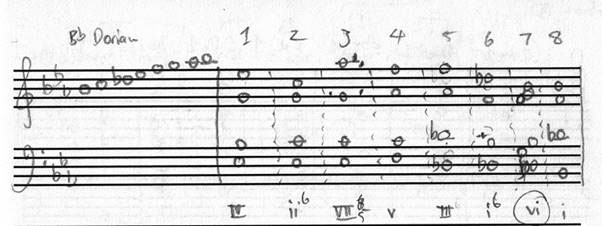
Example 1a

Example 1b
The first two sections of Liber Primus however, use the same material in a more subtle way. During its initial section (A), the first phrase as outlined by double bar lines contains the first chord of each progression, then the second chord of each progression in the second phrase, and then the third and so on… The seven chords in each phrase are arranged in a manner that progression between them is smooth, with some repeated to provide the vocalist a breath. Each chord is either two or three quavers long (2/8 or 3/8) and, apart from an occasional exception, incorporates one word of text.
In section A2 the chord progressions are repeated, but in retrograde (reverse order), and any chord that was two quavers long in section A becomes three quavers long in A2 and vice versa. This method of 'mixing up' the order of the original progressions creates a consistent modal flavour continually varied by a lack of tonal centre. Refer to examples 2a and 2b. Example 2a includes a scan of my handwritten sketch for the first two phrases with the un-arranged chords on the left and the arranged versions on the right. Example 2b includes a score excerpt showing their application, with the vocalist again embellishing the basic progressions.
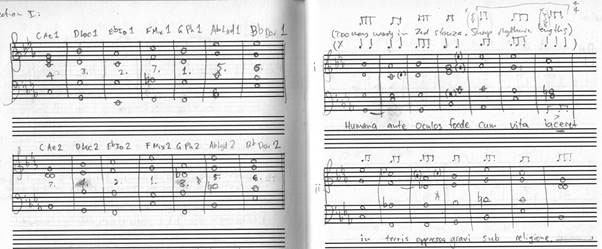
Example 2a
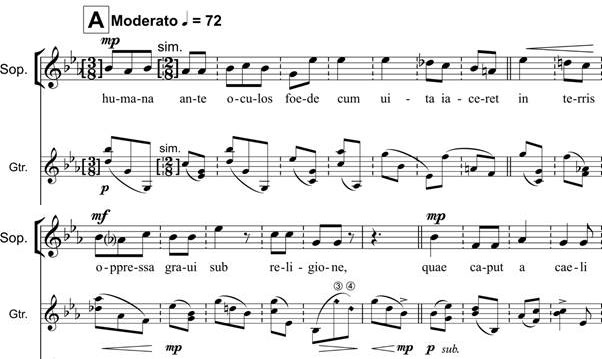
Example 2b
The second song of De Rerum Natura for voice, recorder or flute and percussion, applies pitch material that is influenced by ancient Greek musical theory. The foundational component of ancient Greek modes and pitch systems was tetrachords (groups of four pitches), always a perfect fourth in width, of which the lowest interval was normally a small interval. These tetrachords were then joined together to create scales and pitch systems that were the foundation of their vocal and instrumental material.
According to Landels3, there were three foundational tetrachords in common usage. The first of these is the most familiar to our current system of music, known as the 'Diatonic', and includes a semitone then 2 tones encompassing overall the interval of a perfect fourth and shown in example 3a.

Example 3a
The second was known as the 'Chromatic', and includes two semitones and a minor 3rd, shown in example 3b.

Example 3b
The third type of tetrachord was microtonal, known as the 'Enharmonic', and includes two quartertones and a major 3rd, shown in example 3c.

Example 3c
The "Diatonic" also had a variation known as the 'Soft Diatonic' in which the second note from the top was lowered by a quartertone, shown in example 3d.

Example 3d
These 4 tetrachords are the basis of the pitch material in the work's second song and are used to create two fixed-register pitch schemas where successive tetrachords are built upon the top note of the one below, or are built a perfect 5th higher than the bottom note of the one below. This is similar to the manner in which the ancient Greeks constructed their pitch systems, only in the systems I derived all four of the different tetrachords are applied in contrast to the ancient Greek systems where only the one type of tetrachord was applied throughout. These two pitch schemas are shown in example 4a (used for sections A and C) and example 4b (used in section B).

Example 4a

Example 4b
These pitch schemas are used in conjunction with various number patterns that determine the order of the pitches within each tetrachord and the order of the tetrachords themselves. Sections of the recorder/flute part also only emphasise 1 pitch from each mode at a time, which enables the development of counterpoint and harmony with the voice. The lyrics somewhat expectedly determine the rhythm of the vocal part, but also often the rhythmic length of the recorder/flute part as well. This is determined by the number of syllables in the text divisions (usually divided into 6-word sections). The excerpt of text shown below is an example of how this is determined in section A, with each division of text outlined by a vertical line (|):
nec persectari primordia singula | quaeque, ut uideant qua quicque geratur | cum ratione. at quidam contra haec, | ignari materiai, naturam non posse deum | sine numine reddunt tanto opere humanis rationibus …
Excluding the first four words (used in the introduction), the syllable numbers in the different divisions result in the following number series: 12, 10, 15, 19 … which is applied using quavers as the foundational rhythmic length. The start of each pitch is also emphasised by percussion, and is shown in example 5 which contains a score excerpt from section A.
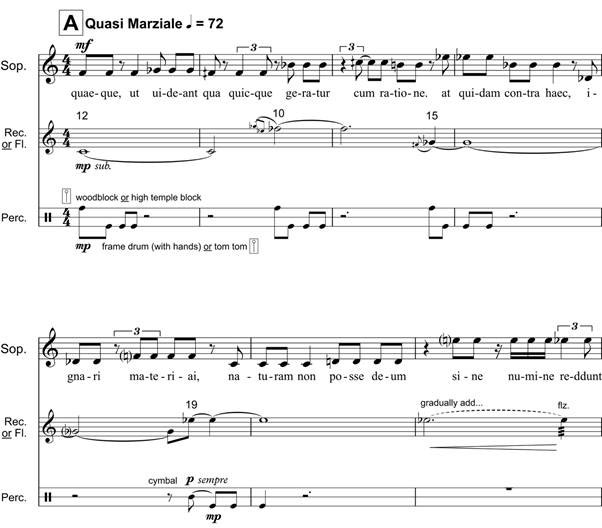
Example 5
Similar number series derived from the number of syllables in the
text divisions are also applied in sections B and C of Liber
Secundus. These techniques create a sound world that is
reminiscent of what music may have been like during antiquity,
but adapted and expanded with a more modern edge.
Brad Gill: We Dwell Alone
A significant opportunity for a composer shaped in a university context is the opportunity for exposure to other disciplines or fields of study, often by international experts in their field. For me, that meant the mandatory undertaking of non-musical humanities units as a component of honours, and I had the good fortune of attending lectures and tutorials by Professors Dr Carole Cusack and Peter Oldmeadow in comparative religion studies and Buddhist Studies at the University of Sydney. This opportunity to deepen knowledge and understanding around subjects I'd been interested in for a long time seeded a scholarly interest, which I pursued in further study, of Pali (with Dr Mark Allon) as well as a drive to explore in practical terms what Buddhist practices such as meditation entailed through time spent at three Sydney monasteries.
My interest in working with texts associated with Buddhism arose during my undergraduate studies from a desire to integrate these interests with my composition development, and a more mature, nuanced form of the same aspiration continues to motivate much of my work. My interest in working with the Pali language4 in particular in two series of works over the past seven years stems from a love of the language I gained from previous studies, the connection of Pali texts to the earliest generations of Buddhists, a love of the sound of the language and an emotional connection to much of the content and ideas expressed.
Discussed below is We Dwell Alone, the second out of a series of Five Pali Songs which I began in 2014. Two of these songs are for an ensemble of soprano voice, violin, trombone, flute and percussion; two are for soprano voice and vibraphone. We Dwell Alone is for soprano voice, vibraphone and bass flute. It, along with three others of the four have been recorded and either released on previous Sideband albums5, or in the case of We Dwell Alone, will be included in a forthcoming album. The fourth song is yet to be produced.
Five Pali Songs
Five Pali Songs is a set of songs setting five Theragatha ('verses of the elders') and they are attributed to early generations of Buddhist monks (more correctly bhikkhus). A parallel collection exists documenting verse of elder nuns (bhikkhunis). Many of these poems convey feelings of bliss upon 'release' and may depict peaceful nature scenes and contain images in themselves beautiful which also serve as metaphors for doctrine. Yet for me, many seem unconvincing as artefacts of solid results of practice. I was inspired by the approach adopted by Australian artist Arthur Boyd in his connected series of works concerning St Francis of Assisi in which he eschews hagiography and focusses on the human side of the saint6. My interpretation of this 'human' interior landscape depicted in the poem is outlined below.
Composed between 2016-2017 and subsequently reworked after workshopping during a residency at the Blacktown research and development space in late 2020, We Dwell Alone encompasses many elements that are core to the Five Pali Songs cycle completed so far, whilst also exploring improvisation and relative levels of freedom for the performers. Below is the text for this song and my English translation (some liberties have been taken in the poem's second half).
The text for We Dwell Alone is Theragatha 62 - Vajjiputta.
Ekakā mayaɱ araññe viharāma
Apaviddhaɱ va vanasmiɱ dārukaɱ
Tassa me bahukā pihayanti
Terayikā viya saggagāminanti.
We dwell alone in the forest,
Like a log rejected in the woods.
Many envy me,
Like beings in hell might envy someone soaring to heaven.
The poem immediately attracted me when I first read it. I've stayed at monasteries for extended periods of time at one point in my life and so the image of peaceful collective solitary living is familiar and appealing. However, dig beneath the surface and there clearly seems to be hubris - 'many envy me'; I have seen this rendered as 'may have envied me', and not all renderings bring out the sense of self-superiority, but it is there, and surely undermines the sense of calm and balance suggested in the first two lines.
The sound of the gatha in its original language were strongly suggestive of musical ideas, and the opening word 'Ekakā' immediately triggered the opening three phrases of the song - low, gritty vowels in the soprano voice emerging from a hard 'kh' sound, meandering microtonally amidst a bubbling, barely audible vibraphone and sustained bass flute. The subsequent repetition of this idea setting up listener expectations that are quickly frustrated musically renders the hesitancy and insecurity beneath the calm condiment surface of the text.
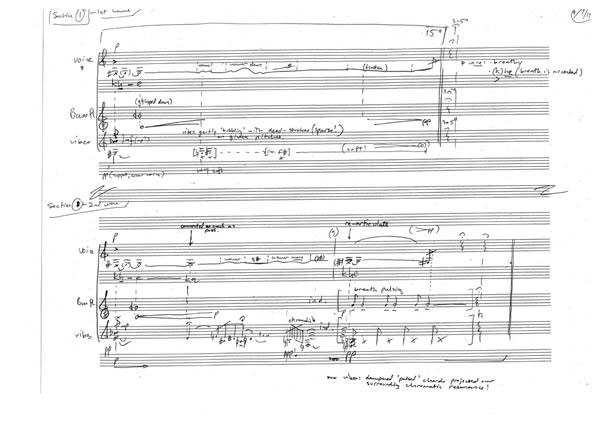
Example 6
An ongoing preoccupation of mine over the past decade has been to convincingly facilitate a solution between giving total freedom to one performer who would respond to a relatively fixed performance from another. This interest first arose in response to an opportunity to write for trombonist Barrie Webb and marimba specialist Keiko Abe as at the time, Ms. Abe's involvement would only have been possible as an improviser due to problems with her eyesight. Solutions presented by my co-author7 and my participation as a performer in improvisation-based settings suggested approaches that developed into those explored in We Dwell Alone, which is the first piece of mine I consider entirely convincing in terms of combining flexible notated material with improvised input.
In We Dwell Alone, the specific strategies used are:
• The cultivation of an improvisational disposition in the
performers as individuals and trio; concretely, this began in
workshopping and continued through rehearsals to engender a
relaxed openness to engaging from a place of not
knowing8.
• The use of 'time-space notation' (play 'x' within 'x' duration,
refer to example 6).
• The use of boxed fully or partly notated material in each part,
that does not necessarily align rhythmically (refer to example
7).
• Near total freedom - mainly in the vibraphone part throughout
the opening sections discussed so far, with restrictions
indicated in written instructions.
• Fully improvised sections where all performers improvise freely
with only very limited suggestions.
In We Dwell Alone, this final point is achieved through improvisation using specific material in the bass flute and vibraphone. A final increase in volume, register and intensity suddenly cut off to only a very soft sustained sonority musically represents the souring to heaven emerging from the 'many envy me' hubris behind this image (refer to example 8).

Example 7
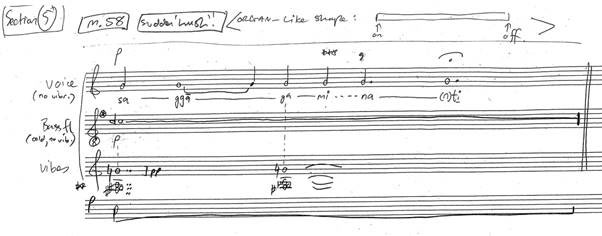
Example 8
The soprano voice has their own set of instructions, to quite freely engage with the sounds of the text and her own pitch material and her 'score' for this improvised section is shown in Example 9 (opens in a new window).
Another preoccupation is the layering of different harmonic layers, exploring the concept of a landscape of harmonies or harmonic fields as well as ideas of the inner landscape mirroring the outer. My current approach to this was informed by a PhD thesis regarding Ligeti's Hamburg Concerto9 in which the field of different 'sizes' of major seconds realised through various natural horn intervals in the first movement along with twelve-note-equal-tempered forms in the strings is described in this way, as well as writings by Australian ex-pat composer David Lumsdaine such as Chaotic Harmony. In each case, these sources helped to clarify existing concepts I've independently evolved over a number of years.
Footnotes
1. G. O Hutchinson, 'The Date of De Rerum Natura', Classical Quarterly April 2006, 152-5
2. See John G. Landels, Music in Ancient Greece and Rome, (Routledge New York, 1999), 172-205
3. Landels (1999), 88-91
4. Pali is the canonical language of Theravada Buddhism, the form currently prevalent in Thailand, Sri Lanka and Myanmar. Theravada sees itself as the most authentic form of extant Buddhism; and whilst this perspective is increasingly seen as problematic, the earliest strata of Pali texts do have a claim to recording very early pre-sectarian Buddhist belief, ideas and culture (Analyo, 2013; Salomon, 1999; Norman, 1994). Much of the extant Pali literature is doctrinal, didactic and analytical. Many early Pali texts also contain poetry or make use of striking analogy and metaphor and it is these types of texts I focus on in musical exploration.
5. The Colour of Blue Clouds:
https://sidebandcollective.bandcamp.com/track/the-colour-of-blue-clouds,
You Are Found Wanting:
https://music.youtube.com/watch?v=queuVvUVioI&feature=share,
Old Age Falls:
https://music.youtube.com/watch?v=DlnhCMols-0&feature=share
6. Margaret Pont (2004) Arthur Boyd & Saint Francis of Assisi: The St. Francis Pastels, Lithographs and Tapestries, 1964-1974, Macmillan Art Publisher
7. Peter McNamara (2013), Freedom Within the Prism, Resonate online magazine, https://www.australianmusiccentre.com.au/article/insight-freedom-within-the-prism (accessed 24.04.2021)
8. The notion of engaging in art practice from a starting point of 'not knowing' was clarified for me by Edelholm in his 2015 Master's thesis 'Exploring Spaces of Not Knowing: an artist's view', as well as through research into embodied cognition theory, notably Schyff (2017) and Lacertos's fascinating 'Interpreting Dao between 'Way-making' and 'Be-wegen''. For me, the notion of improvising in either undetermined or in predefined contexts (such as the mostly composed We Dwell Alone) is to explore it as an extension of Chan practice, operating from a standpoint of so-called empty mind. Implementing this strategy in conjunction with musically exploring Buddhist poetry is another level of engaging with the texts, or perhaps more correctly, the experiences inspired the creation of this ancient poetry.
9. Charles Corey (2011), Pitch and Harmony in Gyorg Ligeti's Hamburg Concerto and Syzygy for String Quartet, (Unpublished) PhD, University of Pittsburgh
Further Reading
Analayo (2013) Perspectives on Satipatthana, Windhorse Publications
Edelholm, Nike Svensson (2018) Exploring Spaces of Not Knowing: an artist's view, independent thesis (Masters), Department of Visual Arts and Sloyd Education, NoVA, Nordic Visual Studies and Art Education
Lacertosa, Massimiliano (2018) 'Interpreting Dao between 'Way-making' and 'Be-wegen'', in Ancient and Modern Practices of Citizenship in Asia and the West (pp.103-120), University of Amsterdam Press
Lumsdaine, David (1996) Chaotic Harmony, (unpublished)
Norman, K. R. (2001, 2015) The Group of Discourses: Translation of the Suttanipata, Pali text Society
Norman, K. R. (1994) A Philological Approach to Buddhism: The Bukkyō Dendō Kyōkai Lectures 1994, Pali text Society - for anyone interested, this is now also available free online here: http://www.ahandfulofleaves.org/documents/A%20Philological%20Approach%20to%20Buddhism_TBFVol5_Norman_1994.pdf
Salomon, Richard (1999) Ancient Buddhist Scrolls from Gandhara: The British Library Kharosthi Fragments (Gandharan Buddhist Texts, University of Washington Press
Warder, A. K. (1963) Introduction to Pali, Routledge
© Australian Music Centre (2021) — Permission must be obtained from the AMC if you wish to reproduce this article either online or in print.
Comments
Be the first to share add your thoughts and opinions in response to this article.
You must login to post a comment.